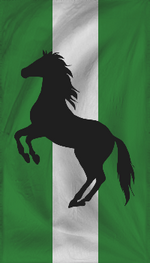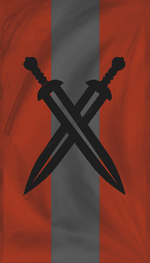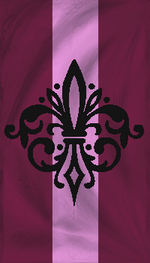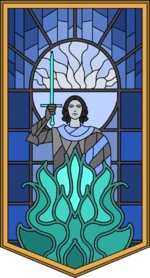More actions
mNo edit summary |
|||
| Line 92: | Line 92: | ||
*Wirtem and Ithanian Ailor are the strongest supporters of knighthood, though both for different reasons. The Wirtem see the knight as an essential part of the battlefield, whereas the Ithanians see them as the perfect entertainment for festivals. Still, it is just as common to see a Wirtem knight competing in a tournament as it is to see an Ithanian knight commanding soldiers on the front lines. | *Wirtem and Ithanian Ailor are the strongest supporters of knighthood, though both for different reasons. The Wirtem see the knight as an essential part of the battlefield, whereas the Ithanians see them as the perfect entertainment for festivals. Still, it is just as common to see a Wirtem knight competing in a tournament as it is to see an Ithanian knight commanding soldiers on the front lines. | ||
*Some knights have become early adopters of firearm weapons, though still prefer to fight with lance and sword on the battlefield, relegating the new technology to the hunting trails. | *Some knights have become early adopters of firearm weapons, though still prefer to fight with lance and sword on the battlefield, relegating the new technology to the hunting trails. | ||
==Language Table== | |||
{| class="wikitable" | |||
|- style="font-weight:bold; background-color:#c2c2c2;" | |||
! Language (Inspiration) | |||
! Description | |||
|- | |||
| style="background-color:#eef5e9;" | Calem (German) | |||
|test | |||
| Spoken by the Wirtem. | |||
|- | |||
| style="background-color:#eef5e9;" | Skodje (Nordic) | |||
|test | |||
| Spoken by the Velheim. | |||
|- | |||
| style="background-color:#eef5e9;" | Common (English) | |||
|test | |||
| The language of global communication. | |||
|- | |||
| style="background-color:#eef5e9;" | Etos (Greek) | |||
|test | |||
| Spoken by the Aetosians. | |||
|- | |||
| style="background-color:#eef5e9;" | Lëtz (Luxembourgish) | |||
|test | |||
| Spoken by the Leutz-Vixe Regal sub-group. | |||
|- | |||
| style="background-color:#eef5e9;" | d'Ithanie (French) | |||
|test | |||
| Spoken by the Ithanians. | |||
|- | |||
| style="background-color:#eef5e9;" | Dressalo (Italian) | |||
|test | |||
| Spoken by the Dressolini Regal sub-group. | |||
|- | |||
| style="background-color:#eef5e9;" | Daendroquin (Spanish) | |||
|test | |||
| Spoken by the Daendroque. | |||
|- | |||
| style="background-color:#eef5e9;" | Anglian (Dutch) | |||
|test | |||
| Spoken by the Anglians. | |||
|- | |||
| style="background-color:#eef5e9;" | Breizh (Breton) | |||
|test | |||
| Spoken by the Breizh. | |||
|- | |||
| style="background-color:#eef5e9;" | Gallwech (Scots Gaelic) | |||
|test | |||
| Spoken by the Gallovians. | |||
|- | |||
| style="background-color:#eef5e9;" | Aontaithe (Irish Gaelic) | |||
|test | |||
| Spoken by the Aontaithe Gallovian sub-group. | |||
|- | |||
| style="background-color:#eef5e9;" | Kriv (Ukrainian) | |||
|test | |||
| Spoken by the Krainivaya. | |||
|- | |||
| style="background-color:#eef5e9;" | Dvalan (Serbo-Croatian) | |||
|test | |||
| Spoken by the Dvala Întuneric sub-group. | |||
|- | |||
| style="background-color:#eef5e9;" | Altalar (High Elven) | |||
|test | |||
| Spoken by the [[Altalar]]. | |||
|- | |||
| style="background-color:#eef5e9;" | Allorn (Unique) | |||
|test | |||
| Spoken by the Allorn [[Altalar]] and a few holdouts. | |||
|- | |||
| style="background-color:#eef5e9;" | Suvial (Elven Hindi) | |||
|test | |||
| Spoken by the [[Suvial]]. | |||
|- | |||
| style="background-color:#eef5e9;" | Sulvaley (Elven Arabic) | |||
|test | |||
| Spoken by the [[Isldar]]. | |||
|- | |||
| style="background-color:#eef5e9;" | Sinnayed (Unique) | |||
|test | |||
| Spoken by the [[Sihndar]]. | |||
|- | |||
| style="background-color:#eef5e9;" | Saan (Nahuatl) | |||
|test | |||
| Spoken by the [[Maquixtl]] and [[Yanar]]. | |||
|- | |||
| style="background-color:#eef5e9;" | Réginyelv (Hungarian) | |||
|test | |||
| Spoken by the Szabadok. | |||
|- | |||
| style="background-color:#eef5e9;" | Înnora (Romanian) | |||
|test | |||
| Spoken by the Întuneric. | |||
|- | |||
| style="background-color:#eef5e9;" | Dwarvish (Old Norse) | |||
|test | |||
| Spoken by the [[Dwarves]]. | |||
|- | |||
| style="background-color:#eef5e9;" | Faraddi (Arabic) | |||
|test | |||
| Spoken by the [[Qadir]]. | |||
|- | |||
| style="background-color:#eef5e9;" | Katharic/Pannarokh (Dark Elven) | |||
|test | |||
| Spoken by the [[Kathar]]. | |||
|- | |||
| style="background-color:#eef5e9;" | Sofaal (Malian) | |||
|test | |||
| Spoken by the [[Songaskia]]. | |||
|- | |||
| style="background-color:#eef5e9;" | Wai-lan (Middle Chinese) | |||
|test | |||
| Spoken by the [[Sihai]]. | |||
|- | |||
| style="background-color:#eef5e9;" | Talumpati (Tagalog) | |||
|test | |||
| Spoken by the [[Balantagi]]. | |||
|- | |||
| style="background-color:#eef5e9;" | Shalota (Unique) | |||
|test | |||
| Spoken by the [[Maraya]]. | |||
|- | |||
| style="background-color:#eef5e9;" | Pidato (Indonesian) | |||
|test | |||
| Spoken by the [[Allar]]. | |||
|- | |||
| style="background-color:#eef5e9;" | Zoram (Sanskrit) | |||
|test | |||
| Spoken by the [[Slizzar]]. | |||
|- | |||
| style="background-color:#eef5e9;" | Ibeth (Ancient Egyptian) | |||
|test | |||
| Spoken by the [[Asha]]. | |||
|- | |||
| style="background-color:#eef5e9;" | Vasar (Sumerian) | |||
|test | |||
| Spoken by the [[Eronidas]]. | |||
|} | |||
{{Proficiency}} | |||
[[category:Proficiency]] [[category:Charisma Point Buy]] | |||
Revision as of 21:15, 11 September 2022

Bacon ipsum dolor amet tenderloin pork bresaola kielbasa, ham cupim boudin. Jowl chislic rump shank shankle drumstick pork ham hock. Jowl kielbasa rump spare ribs, ham hock ribeye chicken jerky t-bone andouille pork bacon. T-bone andouille prosciutto sirloin, short ribs salami cupim alcatra meatball chislic. Leberkas shoulder flank porchetta ham hock beef ribs pork loin turducken salami shankle tongue meatball sausage.
Core Identity
Something
Bacon ipsum dolor amet tenderloin pork bresaola kielbasa, ham cupim boudin. Jowl chislic rump shank shankle drumstick pork ham hock. Jowl kielbasa rump spare ribs, ham hock ribeye chicken jerky t-bone andouille pork bacon. T-bone andouille prosciutto sirloin, short ribs salami cupim alcatra meatball chislic. Leberkas shoulder flank porchetta ham hock beef ribs pork loin turducken salami shankle tongue meatball sausage.
Something Else
Bacon ipsum dolor amet tenderloin pork bresaola kielbasa, ham cupim boudin. Jowl chislic rump shank shankle drumstick pork ham hock. Jowl kielbasa rump spare ribs, ham hock ribeye chicken jerky t-bone andouille pork bacon. T-bone andouille prosciutto sirloin, short ribs salami cupim alcatra meatball chislic. Leberkas shoulder flank porchetta ham hock beef ribs pork loin turducken salami shankle tongue meatball sausage.
Design
How to do XYZ
Bacon ipsum dolor amet tenderloin pork bresaola kielbasa, ham cupim boudin. Jowl chislic rump shank shankle drumstick pork ham hock. Jowl kielbasa rump spare ribs, ham hock ribeye chicken jerky t-bone andouille pork bacon. T-bone andouille prosciutto sirloin, short ribs salami cupim alcatra meatball chislic. Leberkas shoulder flank porchetta ham hock beef ribs pork loin turducken salami shankle tongue meatball sausage.
List of Knightly Orders
| |||||||||||||||||||||||||||||||||
Trivia
- Knighthood actually predates the Empire by several hundred years, as many former kingdoms had their own knights serving as nobles and military commanders. However, the organized structure of the modern Knightly Orders is a purely Regalian concept.
- Wirtem and Ithanian Ailor are the strongest supporters of knighthood, though both for different reasons. The Wirtem see the knight as an essential part of the battlefield, whereas the Ithanians see them as the perfect entertainment for festivals. Still, it is just as common to see a Wirtem knight competing in a tournament as it is to see an Ithanian knight commanding soldiers on the front lines.
- Some knights have become early adopters of firearm weapons, though still prefer to fight with lance and sword on the battlefield, relegating the new technology to the hunting trails.
Language Table
| Language (Inspiration) | Description | |
|---|---|---|
| Calem (German) | test | Spoken by the Wirtem. |
| Skodje (Nordic) | test | Spoken by the Velheim. |
| Common (English) | test | The language of global communication. |
| Etos (Greek) | test | Spoken by the Aetosians. |
| Lëtz (Luxembourgish) | test | Spoken by the Leutz-Vixe Regal sub-group. |
| d'Ithanie (French) | test | Spoken by the Ithanians. |
| Dressalo (Italian) | test | Spoken by the Dressolini Regal sub-group. |
| Daendroquin (Spanish) | test | Spoken by the Daendroque. |
| Anglian (Dutch) | test | Spoken by the Anglians. |
| Breizh (Breton) | test | Spoken by the Breizh. |
| Gallwech (Scots Gaelic) | test | Spoken by the Gallovians. |
| Aontaithe (Irish Gaelic) | test | Spoken by the Aontaithe Gallovian sub-group. |
| Kriv (Ukrainian) | test | Spoken by the Krainivaya. |
| Dvalan (Serbo-Croatian) | test | Spoken by the Dvala Întuneric sub-group. |
| Altalar (High Elven) | test | Spoken by the Altalar. |
| Allorn (Unique) | test | Spoken by the Allorn Altalar and a few holdouts. |
| Suvial (Elven Hindi) | test | Spoken by the Suvial. |
| Sulvaley (Elven Arabic) | test | Spoken by the Isldar. |
| Sinnayed (Unique) | test | Spoken by the Sihndar. |
| Saan (Nahuatl) | test | Spoken by the Maquixtl and Yanar. |
| Réginyelv (Hungarian) | test | Spoken by the Szabadok. |
| Înnora (Romanian) | test | Spoken by the Întuneric. |
| Dwarvish (Old Norse) | test | Spoken by the Dwarves. |
| Faraddi (Arabic) | test | Spoken by the Qadir. |
| Katharic/Pannarokh (Dark Elven) | test | Spoken by the Kathar. |
| Sofaal (Malian) | test | Spoken by the Songaskia. |
| Wai-lan (Middle Chinese) | test | Spoken by the Sihai. |
| Talumpati (Tagalog) | test | Spoken by the Balantagi. |
| Shalota (Unique) | test | Spoken by the Maraya. |
| Pidato (Indonesian) | test | Spoken by the Allar. |
| Zoram (Sanskrit) | test | Spoken by the Slizzar. |
| Ibeth (Ancient Egyptian) | test | Spoken by the Asha. |
| Vasar (Sumerian) | test | Spoken by the Eronidas. |
| ||||||||||||||||||||||||||||||||||||||



